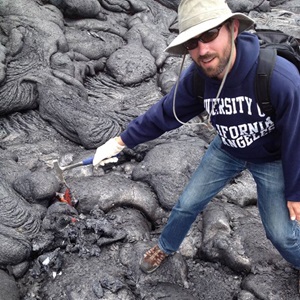Eric Mittelstaedt
Eric Mittelstaedt
Associate Professor
McClure 301C
208-885-2045
Department of Earth and Spatial Sciences
University of Idaho
875 Perimeter Drive MS 3025
Moscow, Idaho 83844-3025
- Ph.D., Geology and Geophysics, 2008—SOEST, University of Hawaii, Manoa
- B.S., Astrophysics, 2002—University of California, Los Angeles
Courses:
- GEOL 422: Principles of Geophysics
- GEOL 433/533: Geodynamics
- GEOL 510: Geosystems
- Tectonic and Magmatic Evolution of Mid-Ocean Ridges
- Mantle Plume-Ridge Interaction
- Hydrothermal Vents
- Analog and Numerical Simulation of Earth Systems
- Plume-ridge interaction in the Northern Galapagos Volcanic Province
Using data collected during the FLAMINGO cruise in 2010 to the Northern Galapagos Volcanic Province, the project attempts to address the impact of plume-ridge interaction on the oceanic lithosphere between the Galapagos Spreading Center and the Galapagos Archipelago. This work involves tectonic reconstructions using magnetic anomalies, analysis of bathymetric data, inversions of gravity data, and numerical models of plume-ridge interaction. - Measuring the Heat and Mass Flux of Diffuse Flow at Hydrothermal Vents
In collaboration with Tim Crone at Lamont Doherty Earth Observatory and Daniel Fornari at the Woods Hole Oceanographic Institution (WHOI), as well as several engineers at WHOI, I am working to develop a new camera system designed to measure the heat and volume flux of diffuse hydrothermal fluids. Measuring the rates at which hydrothermal fluids exit the crust, and how those rates change over time, is critical for understanding these systems and the complex linkages between their component parts. Such measurements can provide information about the structure of permeability in the subseafloor, the geometry of hydrothermal circulation patterns, fluxes of heat and chemicals exchanged with the overlying ocean, and the potential productivity of subseafloor ecosystems. - Quantifying the Mechanics of Ridge Jumps
Hotspots are the surface expressions of localized buoyant upwelling in the mantle (i.e. mantle plumes) and cause anomalous chemistry, crustal thickness, and morphology along ~20% of the world’s mid-ocean ridges. Seafloor magnetic anomalies created at most hotspot-affected ridges reveal significant asymmetric spreading, where more material is accreted to the plate opposite the mantle plume. Much of this asymmetric spreading can be attributed to ridge jumps – discrete shifts of the ridge axis toward the hotspot. Repeated jumps of the axis back toward the hotspot effectively pin the ridge near the plume and, over time, change the geometry of the plate boundary and the shape and size of the tectonic plates. Through numerical simulations, I am attempting to quantify the processes that initiate ridge jumps and control the subsequent plate boundary evolution.







